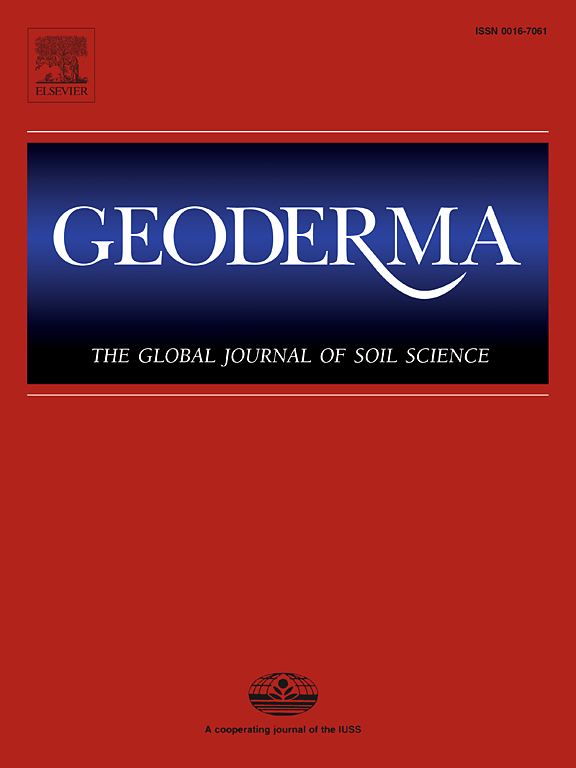数据驱动的土壤盐渍化制图:基于贝叶斯推理的风险预测和不确定性量化
IF 5.6
1区 农林科学
Q1 SOIL SCIENCE
引用次数: 0
摘要
土壤盐碱化对农业生产构成严重的全球性威胁,并已成为土地退化的一个关键问题。为全面探讨土壤盐渍化的风险与不确定性量化,选取山东省典型潮潮土区禹城县作为案例研究区域。2021年10月,利用全球导航卫星系统(GNSS)进行精确定位,从101个采样点收集了土壤样本。采用pr -3001- trrec1 - n01型土壤电导率传感器测定土壤电导率。比较了基于随机偏微分方程(INLA-SPDE)的集成嵌套拉普拉斯近似贝叶斯推理方法在非采样点土壤盐渍化预测中的性能。结果表明,Kriging插值法和INLA-SPDE方法绘制的土壤盐渍化图具有相似的分布格局,但在细节上存在差异。高EC值对应于特定区域,而低EC值在两种方法中是一致的。后验均值,连同95%可信区间的下限和上限,有效地量化了与土壤盐碱化风险相关的不确定性。将房寺乡和新店乡确定为土壤盐渍化高发区,并绘制超概率图供决策参考。相应地,建议实施优化的农田灌溉和排水系统,特别是在低洼地区,以减轻土壤盐碱化。此外,No-U-Turn Sampler (NUTS)、最高后验密度区间(HDI)、Kernel density estimation (KDE)、rank plots和trace plots提高了土壤盐渍化预测的透明度和可解释性。100组预测值的KDE基于数据驱动的土壤EC显示出良好的拟合,与土壤EC相关的较高水平的不确定性对应于使用Theano的高斯分布重叠的区域,作为基于深度学习原理的PyMC3核心组件。本文章由计算机程序翻译,如有差异,请以英文原文为准。
Data-driven soil salinization mapping: risk prediction and uncertainty quantification based on Bayesian inference
Soil salinization poses a serious global threat to agricultural production and has emerged as a critical issue of land degradation. To comprehensively investigate the risks and uncertainty quantification associated with soil salinization, Yucheng County, a typical fluvo-aquic soil area located in Shandong Province, China, was selected as the case study region. In October 2021, soil samples were collected from 101 sampling sites utilizing the Global Navigation Satellite System (GNSS) for precise positioning. Soil electrical conductivity (EC) was measured at these sites using a PR-3001-TRREC-N01 sensor. The performance of Bayesian inference using Integrated Nested Laplace Approximation with the Stochastic Partial Differential Equation (INLA-SPDE) approach for predicting soil salinization at unsampled locations was compared with that obtained using Kriging. The results indicated that the maps generated by the Kriging interpolation and INLA-SPDE approach showed similar distribution patterns for soil salinization but differed in detail. High EC values corresponded to specific regions, while low EC values were consistent across both methods. The posterior mean, together with the lower and upper limits of the 95 % credible intervals, effectively quantified the uncertainty associated with soil salinization risk. Both Fangsi township and Xindian township are identified as high-risk areas for soil salinization with exceedance probability map for policymaking. Correspondingly, the implementation of an optimized farmland irrigation and drainage system is recommended, particularly in low-lying areas, to mitigate soil salinization. Additionally, No-U-Turn Sampler (NUTS), highest-posterior density interval (HDI), Kernel density estimation (KDE), rank plots and trace plots enhanced the transparency and interpretability of soil salinization prediction. KDE of 100 groups of predicted values showed a good fit based on data-driven soil EC, higher levels of uncertainty associated with soil EC correspond to areas where the gaussian distributions overlap using Theano, as PyMC3 core component based on deep learning principles.
求助全文
通过发布文献求助,成功后即可免费获取论文全文。
去求助
来源期刊

Geoderma
农林科学-土壤科学
CiteScore
11.80
自引率
6.60%
发文量
597
审稿时长
58 days
期刊介绍:
Geoderma - the global journal of soil science - welcomes authors, readers and soil research from all parts of the world, encourages worldwide soil studies, and embraces all aspects of soil science and its associated pedagogy. The journal particularly welcomes interdisciplinary work focusing on dynamic soil processes and functions across space and time.
 求助内容:
求助内容: 应助结果提醒方式:
应助结果提醒方式:


